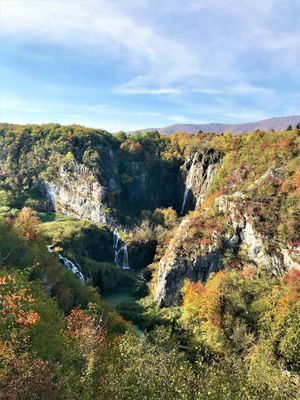Plitvice Lakes National Park - Croatia
Jump to navigation
Jump to search
>>>Back to Case Studies Overview
>>>Add here a title for your case
| Name | Plitvice Lakes National Park | |
| Place | Plitvica Selo | |
| Country | Republic of Croatia | |
| Author(s) | Vedran Vuković | |
| World Heritage | UNESCO World Heritage Site, 1979 | |
|
| ||
Why is this case relevant?
- Plitvice lakes national park is located in the Republic of Croatia and it is the Croatian oldest and largest national park, having that status since 1949. It is located in a mountainous karst region with a surface of just under 300 square kilometers in size. Primarily covered in forest vegetation with some smaller grassland areas and 16 larger and several smaller cascading lakes connected by waterfalls, which are its key feature. The unique characteristic of Plitvice lakes is the biodynamic process of sedimentary tufa rocks formation and consequentially tufa (travertine) barriers which resulted in the creation of the characteristic lakes and waterfalls. This would be the outstanding value of the location which led to its international recognition and its declaration as a UNESCO World Heritage site in 1979. On top of its geological uniqueness, Plitvice lakes is abundantly rich in flora and fauna, out of which a lot are endemic and some have been placed on the red list of protected species, with approximately 1400 plant species present and a large number of animals, including some larger predator species.
Which idea of ‘design with nature’ guides the design concept of this site?
- The largest part of the Plitvice lakes national park comes under strict conservation as entirely untouched or insignificantly touched natural areas rich in biodiversity and natural beauty, as such there is little to no requirements for maintenance or any actions in such areas. Entirely opposite to that the smaller areas concentrated in the vicinity of the larger lakes in Plitvice is a major touristic attraction containing recreational and touristic infrastructure as well as some settlements of cultural importance portraying the traditional way of life as part of the national park’s cultural heritage. These areas require high and active maintenance efforts in order to preserve them as they are and to limit the human influence from high touristic pressure to the relatively small location which needs to remain unaltered as much as it is possible. This constant conflict is what needs to be regularly dealt with as the lack of maintenance or proper planning efforts would have devastating consequences on this landscape.
Which challenges is this landscape facing?
- Here you discuss the types of negative impact you are observing but you can also mention new functions that could give a development opportunity
What would be your strategy for improvement?
Finally, please share some ideas of how you would initiate positive change for your heritage area
Image Gallery
- Yourimage.jpg
your image text and source
- Yourimage.jpg
your image text and source
- Yourimage.jpg
your image text and source
- Yourimage.jpg
your image text and source
- Yourimage.jpg
your image text and source
- Yourimage.jpg
your image text and source
- Yourimage.jpg
your image text and source
- Yourimage.jpg
your image text and source
References
- Author Year: Title, publisher, edition, page, ...
- etc.
- Website Year: Link, keyword, ...
- etc.
